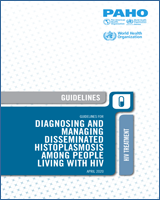Histoplasmosis is a disease caused by the fungus Histoplasma capsulatum. This disease is highly endemic in some regions of North America, Central America, and South America and is also reported in certain countries of Asia and Africa. It often affects people with impaired immunity, including people living with HIV, among whom the most frequent clinical presentation is disseminated histoplasmosis. The symptoms of disseminated histoplasmosis are non-specific and may be indistinguishable from those of other infectious diseases, especially disseminated tuberculosis (TB), thus complicating diagnosis and treatment. Histoplasmosis is one of the most frequent opportunistic infections caused by fungal pathogens among people living with HIV in the Americas and may be responsible for 5–15% of AIDS-related deaths every year in this Region. These guidelines aim to provide recommendations for the diagnosis, treatment, and management of disseminated histoplasmosis in persons living with HIV. Although the burden of disease is concentrated in the Americas, the recommendations presented within these guidelines are applicable globally. These guidelines were produced in accordance with the World Health Organization (WHO) handbook for guideline development. The Guideline Development Group elaborated the final recommendations based on a systematic review of scientific literature and critical evaluation of the evidence available using the Grading of Recommendations, Assessment, Development, and Evaluation (GRADE) approach. These guidelines are intended for health-care providers, HIV program managers, policy-makers, national treatment advisory boards, researchers, and other professionals involved in caring for people who either have or may be at risk of developing disseminated histoplasmosis.
Suggested citation:
Diagnosing and Managing Disseminated Histoplasmosis among People Living with HIV. Washington, D.C.: Pan American Health Organization and World Health Organization; 2020. License: CC BY-NC-SA 3.0 IGO.
General disclaimers. The designations employed and the presentation of the material in this publication do not imply the expression of any opinion whatsoever on the part of the Pan American Health Organization (PAHO) and/or the World Health Organization (WHO) concerning the legal status of any country, territory, city, or area or of its authorities, or concerning the delimitation of its frontiers or boundaries. Dotted and dashed lines on maps represent approximate border lines for which there may not yet be full agreement.
The mention of specific companies or of certain manufacturers’ products does not imply that they are endorsed or recommended by PAHO and/or WHO in preference to others of a similar nature that are not mentioned. Errors and omissions excepted, the names of proprietary products are distinguished by initial capital letters.
All reasonable precautions have been taken by PAHO and WHO to verify the information contained in this publication. However, the published material is being distributed without warranty of any kind, either expressed or implied. The responsibility for the interpretation and use of the material lies with the reader. In no event shall PAHO and/or WHO be liable for damages arising from its use.
Adaptations: If this work is adapted, the following disclaimer should be added along with the suggested citation: “This is an adaptation of an original work by the Pan American Health Organization (PAHO) or the World Health Organization (WHO). Views and opinions expressed in the adaptation are the sole responsibility of the author(s) of the adaptation and are not endorsed by PAHO and WHO.”
Translation: If this work is translated, the following disclaimer should be added along with the suggested citation: “This translation was not created by the Pan American Health Organization (PAHO) and the World Health Organization (WHO). PAHO and WHO are not responsible for the content or accuracy of this translation.”

